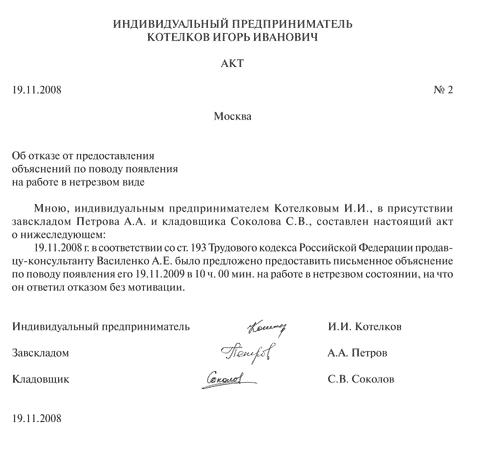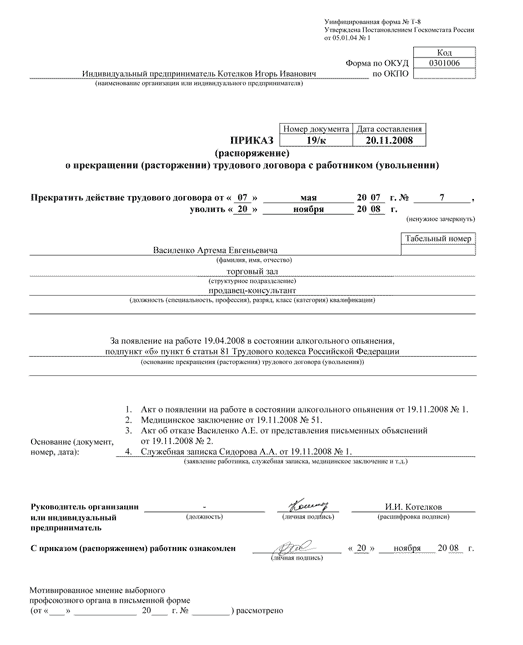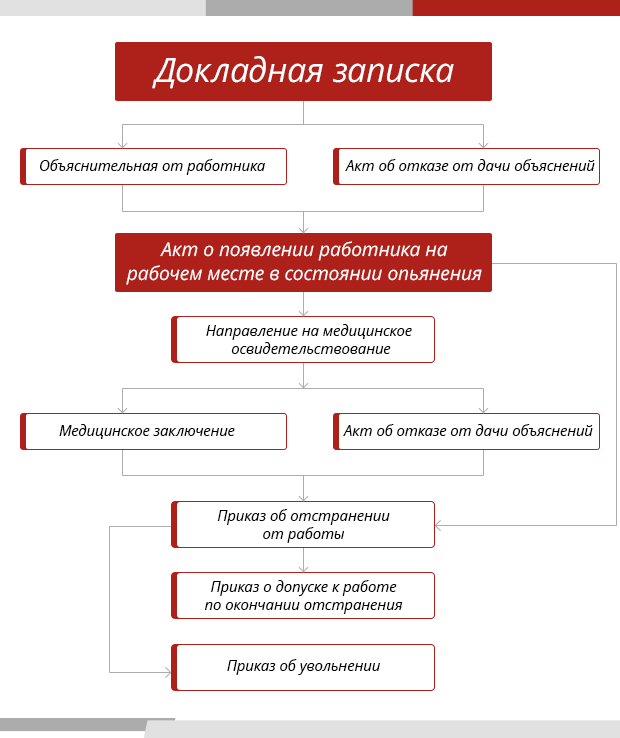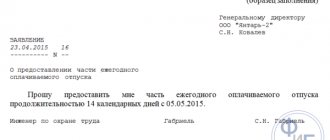Dismissing an employee due to appearing drunk is a difficult procedure due to a number of features. The employer and employee need to understand all the nuances of this situation in order to leave no chance for the unscrupulous party to the labor dispute.
ATTENTION : our labor law lawyer in Yekaterinburg will help both the employee and the employer in the procedure of dismissal for drunkenness: professionally, on favorable terms and on time. Call now!
Testing an employee for alcohol intoxication
An examination is the first step an employer must take when identifying an employee who is intoxicated.
Positive examination results are a prerequisite for the application of measures in the form of suspension from work and punishment. Violation of the examination procedure can lead to serious consequences for the employer in the form of compensation for wages to the employee for illegal dismissal, compensation for moral damage.
Based on the law and established court practice, there are three ways to detect drunkenness in the workplace:
- medical examination at the direction of the employer
- results of pre-trip examination of drivers, machinists and other persons who will be examined by doctors before starting their shift
- examination by the employer.
A medical examination is a way to document the fact that an employee is intoxicated at the workplace by sending him to a medical organization or inviting medical workers. In any case, the basis for examination by doctors is a referral from the employer. The procedure for health workers is described in the order of the Ministry of Health No. 933n. When sending an employee for a medical examination, the employer must know:
- the basis for a medical examination is a referral from the employer in accordance with paragraphs. 5 p. 5
- the examination can be carried out by medical workers of a licensed organization, and the medical organization can be state, municipal or private.
- The absence of a passport by an employee is not a basis for refusal of a medical examination, since on the basis of paragraph 5 of paragraph 5, the identity can be established by a doctor (paramedic) upon referral from the employer
- the results of the examination - a report in the form established by order No. 933n
- possible conclusions upon completion of the examination: state of intoxication established / not established / refused examination.
Pre-trip medical examination of drivers, machinists and other persons who are examined upon starting a shift. A pre-trip examination of a driver, driver or a pre-shift examination by doctors of a person occupying other positions and its results also duly indicate the inability of the employee to begin performing work functions and the reasons.
However, a medical examination is not the only way for an employer to document being intoxicated at the workplace. Based on judicial practice, in particular the guiding clarifications of the Plenum of the Supreme Court No. 16, the employer can confirm the fact of the employee’s drunken state with other types of evidence that must be considered by the court. Thus, other types of recording of facts of intoxication in the workplace, other than the conclusion of medical specialists, cannot be questioned.
The procedure for recording the fact that an employee is intoxicated by the employer is not regulated at the moment. Thus, one should rely on the general norms of labor legislation and office work rules, incl. h. personnel.
Persons authorized to carry out the procedure for recording the fact of drunkenness in the workplace are personnel inspectors due to the fact that the law entrusts them with the function of monitoring labor discipline among employers. In addition, the head of the organization or the immediate supervisor of the offending employee may participate in the procedure.
The form of the act is not established, but it must provide:
- Date, time and place of drawing up the act (03/19/2020, 08 hours 10 minutes, workshop)
- Last names, positions, signatures of employees present when drawing up the act
- Description of the employee’s condition, which allowed us to draw conclusions about his intoxication (shaky gait, smell of alcohol, redness of the skin, behavior inappropriate for the situation, incoherent speech, etc.)
- The act is signed by all persons indicated in it and the employee. Then the employee is asked to write an explanatory note.
If the employee does not want to sign the act, it is necessary to make a corresponding note in the act and also certify it with the signatures of the persons indicated in the act.
We send the employee for a medical examination
In order to completely confirm or refute the fact of intoxication, it is necessary to send the employee for a medical examination. He has the right to be taken to a medical institution that has the appropriate license, equipment and personnel with appropriate qualifications. The examination is carried out at the expense of the employer, but if the fact of intoxication is established, the employer will have the right to recover these expenses from the employee. Delivery to a medical institution is accompanied by a responsible person from the employer. Upon completion of the examination, the medical institution issues a medical report in two copies: one to the employee, the second to the accompanying person from the employer.
According to generally accepted conditions, the medical report will reflect one of the following conditions:
- sober, no signs of alcohol consumption were detected;
- the fact of alcohol consumption was established, signs of intoxication were not identified;
- alcohol intoxication;
- alcoholic coma;
- state of intoxication caused by narcotic or other substances;
- sober, there are functional impairments that require removal from work with a source of increased danger for health reasons.
If it is proven that there was consumption, but no signs of intoxication were detected, the employer does not have the right to remove the employee from work.
However, it is worth noting that the employer does not have the right to force the employee to undergo a medical examination, and the employee has every right to refuse it. In this situation, it is imperative to record this fact by drawing up a Certificate of Refusal of Medical Examination, an example of which you will also find in the appendix to the article.
Suspension from work of an employee while intoxicated
The employer is obliged to suspend an employee if he is found to be intoxicated. Management's decision to dismiss is formalized by an order with which the employee is familiarized. Failure to familiarize an employee with the order of suspension entails serious consequences, since this makes it possible to challenge the amount of payment during the period of suspension and challenge the penalties applied.
If an employee refuses to familiarize himself with the order, this is not an obstacle to his removal. The refusal is recorded in a separate act, and the order itself is subsequently sent to the employee.
The suspension from work must be actual. Formal actions reflected in the documentation must be completed. Failure to comply with them and failure to remove the employee from his work functions entails the full responsibility of the employer.
If an employee is in a state that allows him to fear for his life, health, or for the life and health of others, the employer must take measures:
- Call an ambulance
- Contact the employee's relatives
- Take other measures to effectively suspend and provide medical attention to the employee, if necessary.
USEFUL : read the full procedure for removing an employee from work at the link
How to fire an employee for being intoxicated at work
If an employee appears at work in a state that gives reason to suspect that he is drunk or in a state of narcotic or other toxic intoxication, you should not immediately enter into a conflict with him. It is necessary to record the fact of intoxication, for example, call a doctor for examination or accompany the employee to a sobering-up center, drug treatment clinic or other medical institution and obtain a conclusion about the employee’s condition.
It is advisable for an individual entrepreneur to attend the employee’s examination in person. This is necessary in order to understand whether the examination is being carried out with violations. They are caused by both the negligence of employees of a medical institution and the employee’s refusal to conduct an examination, as a result of which doctors may not carry out the necessary tests. If the examination report reflects that the employee refused to take tests, then from the moment of receiving this report the individual entrepreneur must understand that the examination was not carried out in full and such a report is not adequate evidence that the employee is intoxicated. To ensure that the dismissal is not declared illegal by the court with corresponding consequences for the individual entrepreneur, you should be on the safe side and take care of documenting other evidence.
Despite the fact that examination is a legally flawless way to establish alcohol intoxication, it is quite difficult to use it for a very banal reason - the employee’s reluctance to undergo a medical examination. If the employee resists and does not want to go to a medical healthcare facility, we can assume that the first part of the problem has been solved (we’ll talk about the second a little later). You can resort to the services of security (if there is one) or call the police for help. True, in the latter case, it is necessary to remember that the police officers are not obliged to comply with the request of the entrepreneur to deliver an employee who is intoxicated to a medical facility (although more often than not they still help rather than refuse). You can also go another way - call an ambulance (outlining over the phone a more or less plausible reason for the call (for example, poisoning) and ask the doctors to record in writing the fact that the employee is intoxicated.
As a result of the examination, a medical report may be issued, which will establish one of the following conditions of the employee:
1) sober, no signs of alcohol consumption;
2) the fact of alcohol consumption has been established, no signs of intoxication have been identified;
3) alcohol intoxication;
4) alcoholic coma;
5) a state of intoxication caused by narcotic or other substances;
6) sober, there are functional impairments that require removal from work with a source of increased danger for health reasons.
It should be noted that the current legislation does not directly establish the need for a medical certificate to dismiss an employee on the grounds we are considering. Moreover, the resolution of the Plenum of the Supreme Court of the Russian Federation dated March 17, 2004 contains an indication that “the state of alcoholic... intoxication can be confirmed both by a medical report and by other types of evidence, which must be assessed accordingly by the court.” Such evidence may include:
- witness's testimonies;
- reports of appearing at work in a state of alcohol, drug or other toxic intoxication;
- memos of officials.
Let's figure out how they can and should be formalized.
An individual entrepreneur should not particularly count on oral testimony in court (if the case goes to trial). By the time the labor dispute with the dismissed person is considered, yesterday’s employee-witnesses may themselves quit, “forget” what exactly happened, not come to the court hearing, etc. Therefore, it is preferable to draw up an act, which, if signed by several employees, can be considered as written testimony.
The report on the appearance of an employee in a state of alcoholic (drug, etc.) intoxication is drawn up in free form, but it must indicate:
1) date, place and time of compilation;
2) Full name and the position of the person who drew up the act;
3) persons (preferably at least two) in whose presence the act was drawn up. Ideally, these will be persons who are not related to the offender, for example, employees of other departments);
4) the employee’s condition, which should be described in as much detail as possible, indicating external signs that give reason to assume that the employee is drunk (incoherent speech, unsteady gait, lack of coordination, presence of odor, etc.);
5) signature of the person who drew up the act;
6) signatures of persons present when the act was drawn up.
A sample act is given in Example 1.
Example 1
The employee may refuse to mark the acquaintance on the document. In this case, it is necessary to draw up another act - about the employee’s refusal to sign, or to make the corresponding o) on the first act.
Then it is necessary to invite the employee to provide written explanations about what happened. If he refuses to provide such explanations, another act is drawn up, a sample of which is given in Example 2.
Example 2

Example 3

And yet, it must be borne in mind that the presence of only an act and/or memo about the employee appearing in a state of intoxication without a medical report sharply reduces the entrepreneur’s chances of proving the legality of the employee’s dismissal on this basis.
The reason for this state of affairs is judicial practice, which for many years has developed in such a way that the courts only recognized a medical report as evidence of dismissal of workers under this article, since from the point of view of judges, only a qualified specialist, that is, a doctor, can determine the real condition of an employee. Therefore, it is possible to formalize the dismissal of an employee only if all the documents listed above are in hand, that is, a medical report, acts and memos.
If all documents are available, you can issue an order for his dismissal using the unified form No. T-8. The text of the order should indicate the basis for dismissal - for appearing at work while intoxicated with reference to subparagraph "b" of paragraph 6 of Article 81 of the Labor Code of the Russian Federation, and at the end of the order provide a link to the completed documents as a basis. A sample order form is in Example 4.
Example 4

In addition, upon dismissal, a settlement note must be drawn up upon termination of the employment contract with the employee (Form No. T-61). It is drawn up in a standard manner, just like in other cases of dismissal. After the order is issued, it is necessary to familiarize the employee with it against his signature and make the final payment.
You should also give the employee a work book with a record of dismissal, ask him to sign in the work book (see Example 5) and in the Book of Accounting for the movement of work books and inserts in them about receipt of the work book.
Example 5

Then you should complete the registration of the employee’s personal card (Form No. T-2), entering there the basis for the employee’s dismissal and asking him to sign on the fourth page of the card (see Example 6).
Example 6

Disciplinary action for appearing while intoxicated
The imposition of a disciplinary sanction is formalized by order. The employee must also be familiar with such an order, otherwise it has no legal force.
In accordance with labor legislation, an employee can be punished for violation of discipline in the following forms:
- Comment
- Rebuke
- Dismissal
- Other forms of collection are prohibited . However, certain categories of employees may be subject to disciplinary sanctions, specified in special disciplinary regulations.
Regarding an employee who appears in a state of intoxication, the employer independently chooses the form. The Labor Code requires the employer to impose a penalty taking into account the severity of the violation of discipline.
Can you be fired from your job for drunkenness?
Dismissal for appropriate reasons is an independent measure of punishment for violation of discipline at work. Labor legislation provides a clear list of violations of labor discipline, which give the right to terminate an employment contract. Showing up at work while drunk is one of these reasons.
Therefore, dismissal on this basis is legal. It is worth clarifying that such dismissal is legal subject to compliance with the procedures for examination, removal and application of “disciplinary measures”. Entering into the work book the grounds for dismissal in the form of drunkenness without grounds is not legal.
Responsibility
Appearing at work in a state of intoxication is a gross violation of labor discipline on the part of the employee, and even committed once is sufficient grounds for dismissal of the employee (clause “b”, paragraph 6 of part one of Article 81 of the Labor Code of the Russian Federation). If the employer plans to resort to this measure, he needs to be especially careful when drawing up documents and following the entire procedure and not neglect the medical examination. If the court finds that the employer did not provide sufficient evidence of the fact that the employee was intoxicated, the dismissal will be declared illegal, and the employer will be obliged to reinstate the employee at work, pay him for forced absence in the amount of average earnings and compensate for moral damage. For illegal deprivation of an employee's right to work, administrative liability may also be applied to the employer and its officials (according to Article 5.27 of the Code of Administrative Offenses of the Russian Federation).
In conclusion, I would like to note that compliance with the removal procedure and proper execution of documents will help mitigate the above risks and establish labor discipline in the organization.

comments powered by HyperComments
Share news:
The entry was published on September 28, 2015 by Alexandra Semakova in the category Organization of labor protection work.
Showing up at work drunk after hours
From a legal point of view, an employee appearing drunk at a non-working place can only be considered an administrative offense in accordance with Art. 20.21 Code of Administrative Offenses of the Russian Federation. The employer should limit itself to calling the police.
In addition, labor legislation provides that the basis for dismissal is the appearance at the workplace of an employee performing a labor function. During non-working hours, the employee does not perform labor functions and cannot be fired for this.
How to fire an employee for drunkenness?
To fire an employee who shows up drunk at work, you must:
- Examine his condition by the employer, by a physician or medical organization at the direction of the employer, or based on the results of a mandatory pre-trip medical examination
- To remove an employee from performing his duties by order. Take measures to effectively remove you from work.
- Issue an order to impose “disciplinary action” in view of dismissal on the basis of clause b) clause 6 of Art. 81 of the Labor Code of the Russian Federation and familiarize the employee with it.
- Issue to the employee or send by mail a notice of termination of the employment contract, the date of its termination, making sure that he is not on sick leave.
USEFUL : watch the video about the dismissal of an employee, and also read the link
Order of suspension
After the employer has received a conclusion with the results of a medical examination from a medical institution or, in its absence, after drawing up a Certificate of the employee being at work, it is necessary to issue an Order on suspension from work and familiarize the employee with it against signature. The order specifies the basis for the suspension, as well as the period for which the employee will not be allowed to perform official duties. As a rule, the period of suspension in case of alcohol intoxication is 1 working day.
The order must contain a note indicating that the employee has familiarized himself with it. In case of refusal to familiarize yourself, you must draw up a Certificate of refusal to familiarize yourself with the order (6) or make a note in the order itself. As a general rule, the act is drawn up in the presence of 2 more employees of the organization, not counting the drafter.
After the end of the suspension period, the employer issues an Order on admission to work , which the employee is also familiarized with accordingly.
How to challenge dismissal for drunkenness or disciplinary action?
Challenging dismissal is an individual labor dispute that can only be resolved by a court. Other authorities may apply administrative measures to the employer.
Challenging dismissal in court is possible within three months from the date of actual dismissal. This is the statute of limitations for individual labor disputes.
As a rule, it is disputed:
- Application of dismissal, legality of its application by the employer
- The fact of being intoxicated at work
In any case, the employee must provide the necessary evidence, which may be:
- Testimony of other witnesses
- Regulatory and documentary grounds demonstrating the illegality of applying disciplinary sanctions in the form of dismissal
Help from a lawyer in Yekaterinburg
A labor dispute lawyer is able to properly accompany the procedure of examination, suspension and dismissal of an employee who appears drunk at work, as well as represent the interests of the organization in the event of a dispute with such an employee in court, or claims from supervisory and labor control authorities.
An illegally dismissed employee needs the help of a labor lawyer in order to defend his rights in court, reinstate him at work, and remove a defamatory entry from his work record book.






